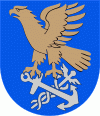Kotka (Aquilopolis) is a city in the southern part of the Kymenlaakso province on the Gulf of Finland. Kotka is a major port and industrial city and also a diverse school and cultural city, which was formerly part of the old Kymi parish; later, Kymi with the Haapasaari island and Karhula, the latter of which once separate from Kymi as the market town, were incorporated into Kotka. The neighboring municipalities of Kotka are Hamina, Kouvola and Pyhtää. Kotka belongs to the Kotka-Hamina subdivision, and with Kouvola, Kotka is one of the capital center of the Kymenlaakso region. It is the 19th largest city in terms of population as a single city, but the 12th largest city of Finland in terms of population as an urban area.
Kotka is located on the coast of the Gulf of Finland at the mouth of Kymi River and it is part of the Kymenlaakso region in southern Finland. The city center is located on an island surrounded by the sea called Kotkansaari ("Island of Kotka"). The most important highway in Kotka is Finnish national road 7 (E18), which goes west through Porvoo to Helsinki, the capital of Finland, and extends east to St. Petersburg, Russia. The Port of Kotka is a major Finnish sea port that serves both the foreign trade of Finland and Russia. The municipality is officially unilingually Finnish, with 89.8% being native Finnish speakers, 1% Swedish, and 9.3% speaking some other language.
The description of the older coat of arms read that "the upper field of the split shield is blue, the lower field silver, and in the center of the shield a natural stone with a golden eagle, and in the lower field the anchor and caduceus diagonally crossed, both blue," while the current coat of arms is described as follows: "In a blue field, the wings of a golden natural eagle are raised, standing with a crossed anchor and caduceus, both of which are silver." The first coat of arms of the city of Kotka was confirmed in 1881. However, the Kotka City Council had to renew the old coat of arms in 1954 because it did not meet heraldic requirements. The new coat of arms was designed by Olof Eriksson in 1957, Eriksson kept the new coat of arms as the main emblem of Kotka referring to the name of the city. From the images of the current coat of arms, the anchor reflects the importance of Kotka as a port town and caduceus in trade, industry and maritime traffic.


















